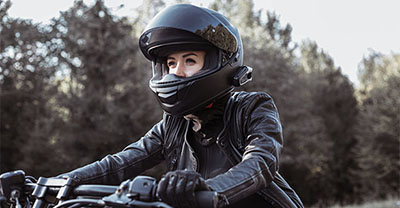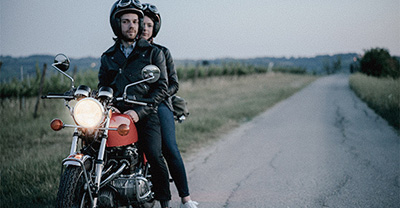Types of motorcycles: Which is best for you?


0 min. read
Are you in the market for a motorcycle?
If so, you may wonder about your options—and why one style might be better for you than another. You can spot the biggest differences between motorcycle types in key features, price, and ideal riding conditions. Choosing the best option for you depends on your riding experience, location, and personal preferences.
This guide covers the pros and cons of common styles of motorcycles and how to choose the best option for you.
Standard motorcycles

Manufacturers often call standard motorcycles naked bikes or roadsters. This type of bike is recognized as the oldest style in terms of motorcycle manufacturing history. It’s known for its upright seating position and straightforward design—a great choice for short commutes.
Standard motorcycles offer a diverse range of engine sizes, typically from 125cc up to 1000cc, catering to various rider needs and experience levels. Popular manufacturers in this category include well-known brands such Suzuki®, Ducati®, Yamaha®, Triumph®, Honda®, and Kawasaki®.
Pros
Easy handling
Lightweight and agile
Great starter bike
Simple upgrade to a sport standard for increased power
Cons
Limited storage space comparatively
Comfortable for short distances, not long hauls
Low wind protection
Cruisers

Cruisers are one of the most popular motorcycle styles. Manufacturers often make these bikes heavier with low-end torque and design them with a laid-back riding position for comfortable, stylish cruising. These bikes allow riders to enjoy leisurely, relaxed rides, so bikers who like to ride with a motorcycle club often choose them.
Cruiser motorcycles are known for their powerful engines, which typically range in size from 500cc all the way up to 2000cc. Among the popular brands in the cruiser segment are iconic names like Harley-Davidson® and Indian®, as well as offerings from manufacturers such as Kawasaki® and Honda®.
Pros
Many model and customization options
Comfortable, leisurely ride
Timeless, classic look
Cons
Heavier than other styles
Low power-to-weight ratio
Less fuel-efficient
Sportbikes

Sportbikes are among the most popular motorcycle models because manufacturers produce them in a wide range of sizes and offer numerous customization options, making them a versatile choice for many riders. However, they’re particularly well-suited for riders seeking a high-performance motorcycle designed and engineered for speed and maneuverability, especially on paved roads.
Engine sizes typically span from 125cc to 1000cc, with some pushing the boundaries of power. Popular brands such as Honda®, Yamaha®, Kawasaki®, and Suzuki® cater to a broad audience, while premium brands like BMW®, Aprilia®, and Ducati® offer high-end features and performance.
Pros
Lightweight and nimble
Cost-effective
Adjustable suspension
Cons
Not built for comfort
Require more aggressive body positioning and riding skills
Steep rake angle
Less stable at slow speeds
Choppers

Choppers have a distinctive design, which has contributed to their presence in motorcycle culture. Due to their specific handling characteristics, experts generally advise against their use as a first motorcycle. Chopper-style motorcycles are available from certain manufacturers, but a significant portion of these motorcycles are custom-built by specialized shops.
Be aware modifications to factory specifications, including but not limited to frame alterations, extended forks, and changes to braking or lighting systems, may affect insurability and require specific endorsements. Consult with your insurance provider for specific coverage requirements.
Chopper engines typically range from 800cc to 1300cc, and many use a V-twin engine configuration, which delivers the characteristic chopper sound. Common brands offering production choppers include Harley-Davidson®, Yamaha®, Triumph®, and Indian®.
Pros
Iconic, classic styling
Unique, collector showpieces
Minimalist bodywork
Cons
Dramatic rake angle
Challenging handling and cornering
Limited suspension
Touring motorcycles

Manufacturers design touring motorcycles to travel long distances, with comfort, extended ride time, and smooth highway cruising in mind. Some of the main features include good wind protection, plenty of storage space, and a comfortable seat. If you get a fully equipped touring motorcycle, they often have hard luggage capacity components, airbag systems, cruise control, and even built-in air compressors.
Touring engines typically range from 450cc to 1800cc which allows them to haul for long distances and carry extra gear or passengers. Popular touring motorcycle brands include KTM®, BMW®, Kawasaki®, Honda®, and Harley-Davidson®.
Pros
Smooth, stable, and comfortable for riding
Great for long-distance riding
Available from most manufacturers
Often room for a passenger
Cons
Bulky and heavy
Potentially overwhelming for new riders
Higher priced
Less agile in tight spaces
Adventure bikes
Adventure motorcycles (or dual-sport motorcycles) are ideal for those who want to ride off-road. These bikes can handle almost anything you throw at them: sand, gravel, rough roads, mud—and even snow and water. Here are the three main types:
Dirt bikes are made solely for off-road riding. Manufacturers design them specifically for trails, so they don't have headlights, taillights, or other street-legal equipment. You'll find them with 4-stroke, 2-stroke, or even electric engines.
Motorcross bikes are high-performance machines built for racing on dirt tracks with jumps and obstacles. They have high ground clearance, advanced suspension to absorb impacts from jumps, and lightweight frames for maximum agility. Like dirt bikes, they are not usually street legal.
Enduro bikes are built for long-distance endurance racing. They share the high-performance suspension of motocross bikes but have larger fuel tanks so you can go farther between fill-ups. Some enduro bikes are street legal, making them a good option for riders who want the best of both worlds.
Enduro and motorcross bike engines are by definition smaller than a dirt bike’s, ranging from 125cc to 450cc. Dirt bikes go up from there with the highest-powered options reaching 1300cc. Popular brands include Ducati®, BMW®, KTM®, Honda®, and Yamaha®.
Adventure bikes can be tricky when it comes to insurance. It’s important to discuss the intended use of your bike with a potential insurer and disclose any modifications, as they may affect coverage options.
Pros
On and off-road capabilities
Excellent tire grip
Durable
Cons
Complex engine design, making repairs tougher
Non-standard features: small gas tank, kickstart, tall seat height
Some models limited to off-road riding
Scooters

Scooters are small motorcycles that work best for city and suburban environments as they’re quiet and energy efficient. They generally have an automatic transmission, a platform for resting your feet, and a step-through frame.
Scooters come in a range of engine sizes, typically from 50cc to 150cc, though some models can reach up to 500cc for added power and speed. Whether you're looking for a reliable commuter or a stylish urban ride, top brands like Honda®, Yamaha®, Vespa®, and Piaggio® offer a variety of options.
Pros
Small and lightweight
Automatic shifting
Inexpensive running costs
Cons
Limited power and speed
Smaller, so less visible to other drivers
Not as comfortable for longer rides

Electric motorcycles

Electric motorcycles are gaining popularity as manufacturers continue to improve battery technology and performance. These bikes offer a quiet, eco-friendly alternative to traditional gas-powered motorcycles.
From efficient city models to high-performance machines that rival gas-powered sport bikes, there’s an electric motorcycle for every type of rider. Top brands leading the charge include Zero Motorcycles®, Harley-Davidson® (LiveWire®), Energica®, and BMW®.
Pros
Instant torque and smooth acceleration
Low maintenance
Quiet and environmentally friendly
Cons
Limited range compared to traditional motorcycles
Longer refueling time compared to quick fill-up at a gas pump
Fewer charging stations—especially in rural areas
How to choose the best motorcycle for you
Now that you’ve learned about the different types of motorcycles, how do you decide which one is right for you? Personal preference and access play a role, but also take into account these four criteria:
Skill level:
Some motorcycles are more difficult to ride than others. Consider the bike’s weight, rake angle, engine power, and transmission.
Riding style:
Select a motorcycle that aligns with your body type and how you already ride. Look at the riding posture, seat height, handlebar placement, balance, control, and maneuverability.
Lifestyle:
Choose the bike best suited to how you’ll be riding it most often. Is it a commuter or are you taking it on long rides? Think about storage needs, size of the gas tank, fuel efficiency, and stability in highway or city traffic.
Budget:
Of course, you’ll narrow your options based on how much money you want to spend. Remember that costs go beyond the initial sticker price. Budget for motorcycle insurance, registering the vehicle, a helmet and other riding gear, and fuel.
Tips for first-time motorcycle buyers
If this is your first bike, you might want to consider options that are:
Lightweight
Have modest power
Neutral handling
Built so you'll have both feet on the ground
However, the best tip when buying a motorcycle is to choose an option that suits your lifestyle.
What do you want to ride and why?
What do you want to achieve from your new motorcycle?
Are you a relatively fast learner with some experience?
What type of bike will be most compatible with your body type?
New or used motorcycle?
Both new and used motorcycles have advantages and drawbacks. New bikes often include the latest technology, safety features, and a manufacturer’s warranty but may come with higher costs, insurance rates, and depreciation. Used motorcycles can be more budget-friendly and depreciate more slowly, but they may have unknown maintenance histories and lack a factory warranty. It's important to consider cost, reliability, and insurance options before making a decision.
Motorcycle insurance considerations
In nearly every state, motorcycle insurance is mandatory. The required coverage differs from state to state, but you may want to invest in optional coverages to help protect your wallet.
The cost of motorcycle insurance depends on variables specific to you. However, when it comes to the type of motorcycle, your provider generally considers value, safety rating, theft rating, engine size, and other factors—like where the bike is stored and how often it's used.
Since 1996, Dairyland®, a brand of the Sentry Insurance group, has helped motorcycle lovers find affordable, customized insurance. Contact us to get a free quote today!

The general information in this blog is for informational or entertainment purposes only. View our blog disclaimer.
*All product names, logos, brands, and trademarks are property of their respective owners. All company, product, and service names are for identification purposes only. Use of any of the foregoing does not imply endorsement.














